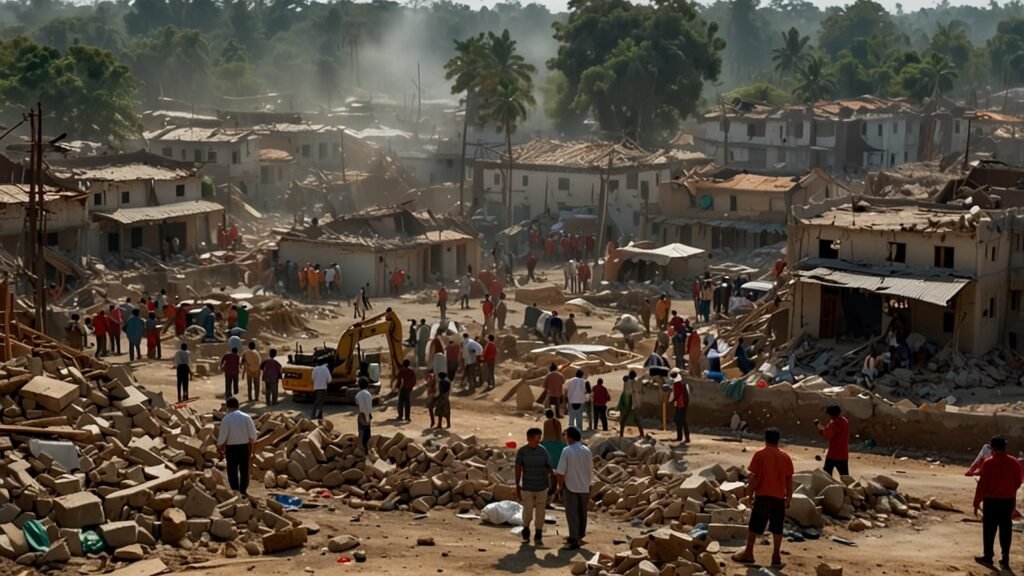
On March 28, 2025, a strong 7.7-magnitude earthquake hit the second-largest city of Myanmar, Mandalay, causing considerable devastation and taking the lives of at least 144 people, with a hundred of them being injured. It has left thousands displaced and ruined infrastructure amongst its aftermath and, with a 6.4-magnitude aftershock following it, claims one of the highest positions as of the deadliest natural disasters of 2025.
According to Le Monde and PBS News, the tremor has shaken Southeast Asia, with other parts of the world providing international aid, and the issue of Myanmar preparing for such a mishap is questionable. This occurrence has been the talk of the world and is currently trending on X as a beacon sign in the region, marking the thin line between being immune to or susceptible to earthquakes.
The Disaster: A Shaking Region
The earthquake tremor occurred at 8:47 am (local time), and the epicentre was positioned right outside the city of Mandalay —a sensational cultural and economic centre. The tremor brought down several buildings, including a skyscraper under construction in the neighboring town of Bangkok, Thailand, where other casualties were noted. In Myanmar, many residential areas, schools, and markets were seriously damaged, and roads and bridges became impassable, which made rescue operations difficult.
Motorcycle footage or videos on X displayed rubble of entire neighbourhoods where people desperately looked under debris to find their loved ones. The scene was described as heartbreaking, with people digging with their hands since heavy machinery is unable to reach the sites, as mentioned in one of the posts.
The aftershock, which measured 6.4 on the Richter scale, occurred several hours later, making rescue work even more complicated and leading to additional structural collapses. The Myanmar military junta reported that the response capacity in the region was overloaded by the disaster caused by the damage to the infrastructure, and the crisis was worsened by it, according to Le Monde.
The humanitarian agencies explained that, in this case, Myanmar was not in a position to handle such a disaster, considering that the country had limited resources and ongoing political instability as one of the major impediments to an effective response.
Injuries and First Aid
Though the number of dead, as reported by the rescue teams, stood at 144, it is likely to increase as rescue teams proceed with the search in the collapsed structures. More than 1,000 have been reported injured, with hospitals in the Mandalay area unable to handle the number of incoming patients.
As CNBC reports, the junta has called for international assistance, and China and other countries have responded by providing aid. The United Nations and local NGOs are organizing relief efforts. Still, roads and the communication system are damaged, resulting in essential supplies, including food, water, and medicine, taking time to reach the people.
Courageous tales of heroes have also been aired, as the CBS news tells of a young girl being pulled out of the rubble of a school alive after being stuck there for more than 24 hours. Nevertheless, aid agencies issue a warning that the time is limited to save those still trapped under the rubble, and the absence of heavy machinery and specialized workers is a significant setback. The X posts on X have brought these efforts to the forefront, as users share images of volunteers and international teams working around the clock, accompanied by messages such as “Hope amidst despair in Myanmar.”
Local Effect and Seismic Situation
The earthquake’s strength was also felt in Southeast Asia, with reports indicating that it shook Thailand, Laos, and parts of India. The falling construction site in Bangkok contributed to the local death toll, as Thai officials announced a zone of disaster in the concerned regions.
The geographical position of the area near the Pacific Ring of Fire has made it susceptible to seismic shocks; however, as observed by scientists, this tremor was highly devastating due to its shallow depth and proximity to highly populated areas.
According to Dr. Aung Kyaw, a seismologist quoted by PBS News, the damage was exacerbated by Myanmar’s outdated infrastructure, as well as a lack of building rules and regulations regarding earthquakes.
A lot of structures were not made to resist these forces, he said, and we should act now to stop this kind of disaster in the future. The tragedy has also rekindled the debate over the effects of climate change on the worsening of natural disasters, with experts attributing the rise in seismic activity to environmental changes, but this is a topic of debate.
Solidarity and Outcry by the People Worldwide
Out of the tragedy, a cry of anguish and solidarity has erupted on X, where hashtags such as #MyanmarEarthquake and #PrayForMandalay have gained popularity. People posted videos of crumpled buildings and appeals to relief funds, and one post said: “The world must rally to support the Myanmar people- they are crying.”
Leaders of other countries around the globe have rallied in solidarity with French President Emmanuel Macron, speaking about the recent Cyclone Chido in Mayotte in France, to demonstrate that countries should work together in responding to disasters.
However, there has also been criticism, with some X users opposing the way the Myanmar junta has handled the crisis, arguing that it has imposed media restrictions and is slow in distributing aid. According to CBS News, the military has closed journalists in some regions, forcing partners of the BBC to carry out undercover reporting to expose the real extent of the disaster.
The Projection of the Future: Rebuilding and Resilience
With Myanmar struggling to deal with the fallout, the burgeoning effort has now turned towards recovery and long-term resilience. According to a United Nations estimate, billions of dollars will be required to rebuild, with the priority being to restore key facilities, including hospitals, schools, and others.
Disaster has also brought to the fore the need for better early warning mechanisms and ensuring seismic preparedness, especially in areas prone to catastrophe, such as those in Southeast Asia.
This is a stark reminder of the unpredictability of natural disasters and the significant investment required by the global community to mitigate their risks. The world will be waiting to see what happens to Myanmar as rescue missions are still going on, and they wish they could hear more tales of how people survived the tragedy.

